Photos by Scott Buschman
It’s lunchtime at Hercules Middle School, and students stream into the library to play chess and card games, build things with Legos, and visit with friends. There is laughing and friendly banter with teacher librarian Angela Anthony, who makes students feel right at home. Unlike school libraries of the past, there is no shushing.
“I like coming here,” says Samuel Kim. “It’s a good place to hang out with friends.”
Hercules Middle School has transformed its library from a quiet, studious setting to an interactive environment that is welcoming to students and fosters 21st century learning. It’s part of a trend happening at school libraries around the country.
Libraries have become livelier
Many schools are turning their libraries into interactive spaces. At Hercules, for example, students recently collaborated to create comics about the Civil War with computers, and made stop-motion videos for their research topics. Students formed a Makerspace Club to design objects on computers for 3-D printers. Such inquiry-based learning makes school fun — and supports the new standards.
(The trend for libraries to support science, technology, engineering, art and math — STEAM — and makerspace activities was first reported in California Educator’s January/February 2017 issue in a profile of Kory Bootsma, a Val Verde Teachers Association member whose students create robots, connect circuitry, and use computer-assisted design programs for 3-D printers.)
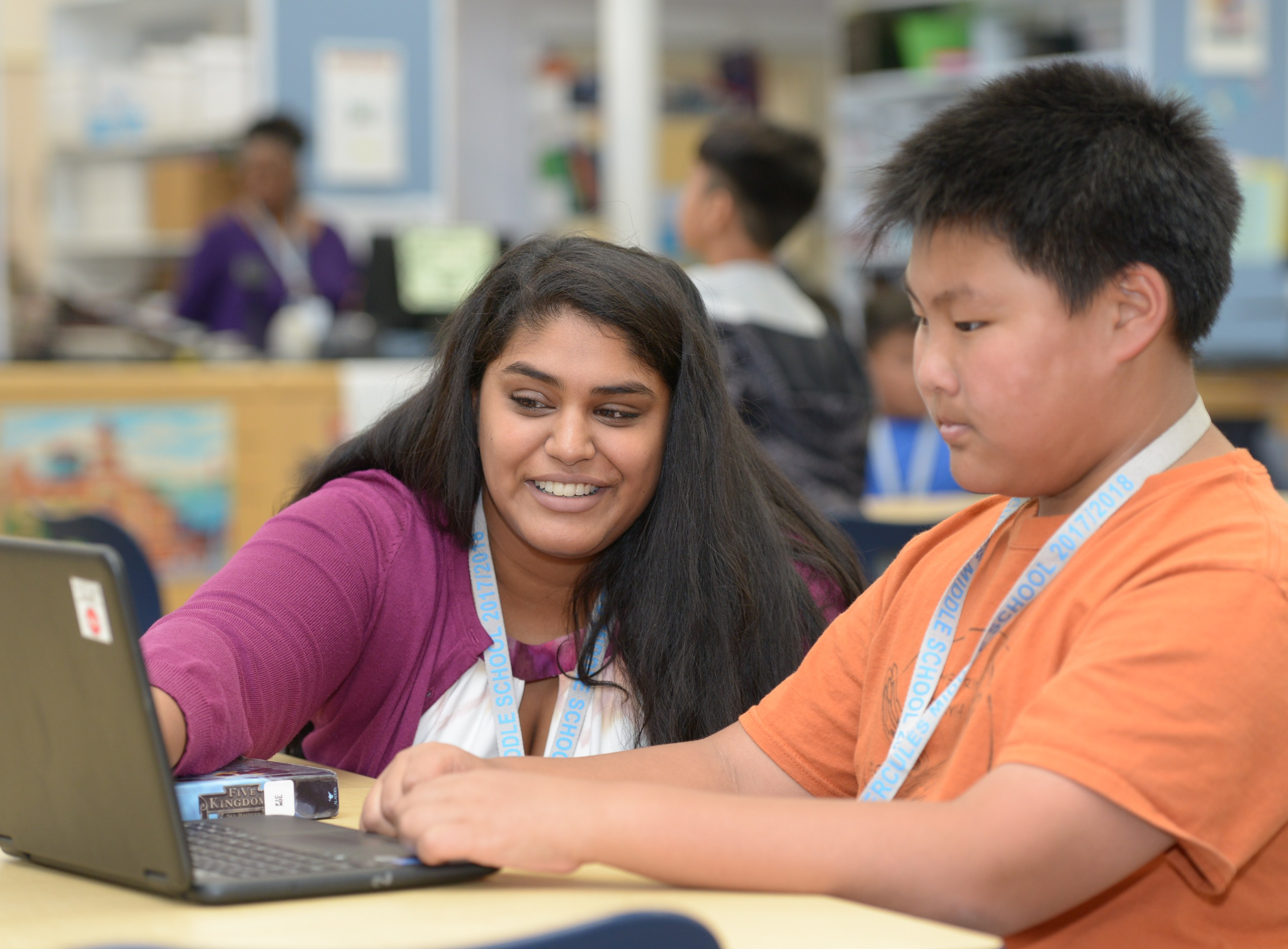
Teacher librarian Angela Anthony at Hercules Middle School with student Samuel Kim.
School libraries have also become more inclusive and safe spaces where students are encouraged to play games and hang out, before and after school and during lunchtime. By serving as campus community centers, libraries are becoming the heart and soul of schools, say librarians.
School libraries may be changing, but books are still important. Teacher librarians report that despite the emphasis on technology, students still enjoy books.
Anthony, a member of United Teachers of Richmond, says students spend more time in the library, so they notice more books that jibe with their interests. She adds that young adult fiction has never been more interesting.
Librarians take on new challenges
Once known for stacking shelves and checking out books, today’s teacher librarians have a variety of responsibilities that may include selecting and managing digital databases, teaching students to navigate and interpret online information (avoiding fake news), sponsoring book clubs, celebrating cultural diversity with art and research projects, supporting STEAM activities, and holding computer programming workshops.
“It’s an awesome job,” says Fresno Teachers Association member Sue Navarro, a teacher librarian who does all these things at Fresno High School. “I’ve been told to stop telling people how much I love my job because people will think it’s not work.”
Most people refer to their “school librarian” on campus, but the correct term is “teacher librarian” for one who has both a teaching credential and a master’s degree in library and information or media science. Another term is “library media specialist.”
Despite having a master’s degree, some say their colleagues think of them as clerks and aren’t aware of what they do. Teacher librarians can support and complement classroom lessons. They save classroom teachers time and work by finding collections of books on subjects they teach, gathering primary sources for social studies lessons, finding relevant lesson plans, gathering curriculum reference materials, showing teachers new apps and tech tricks to make learning fun, and showing students how to use databases with accurate, up-to-date information for research projects.
“I see myself as a bridge builder who can help teachers with all the little things they don’t have time to do,” explains Jennifer Zimny, a teacher librarian at Ponderosa High School in Shingle Springs and member of the El Dorado Union High School District Faculty Association. “We have a very specialized role in schools and are here to support every teacher and classroom. We have a great deal to offer.”
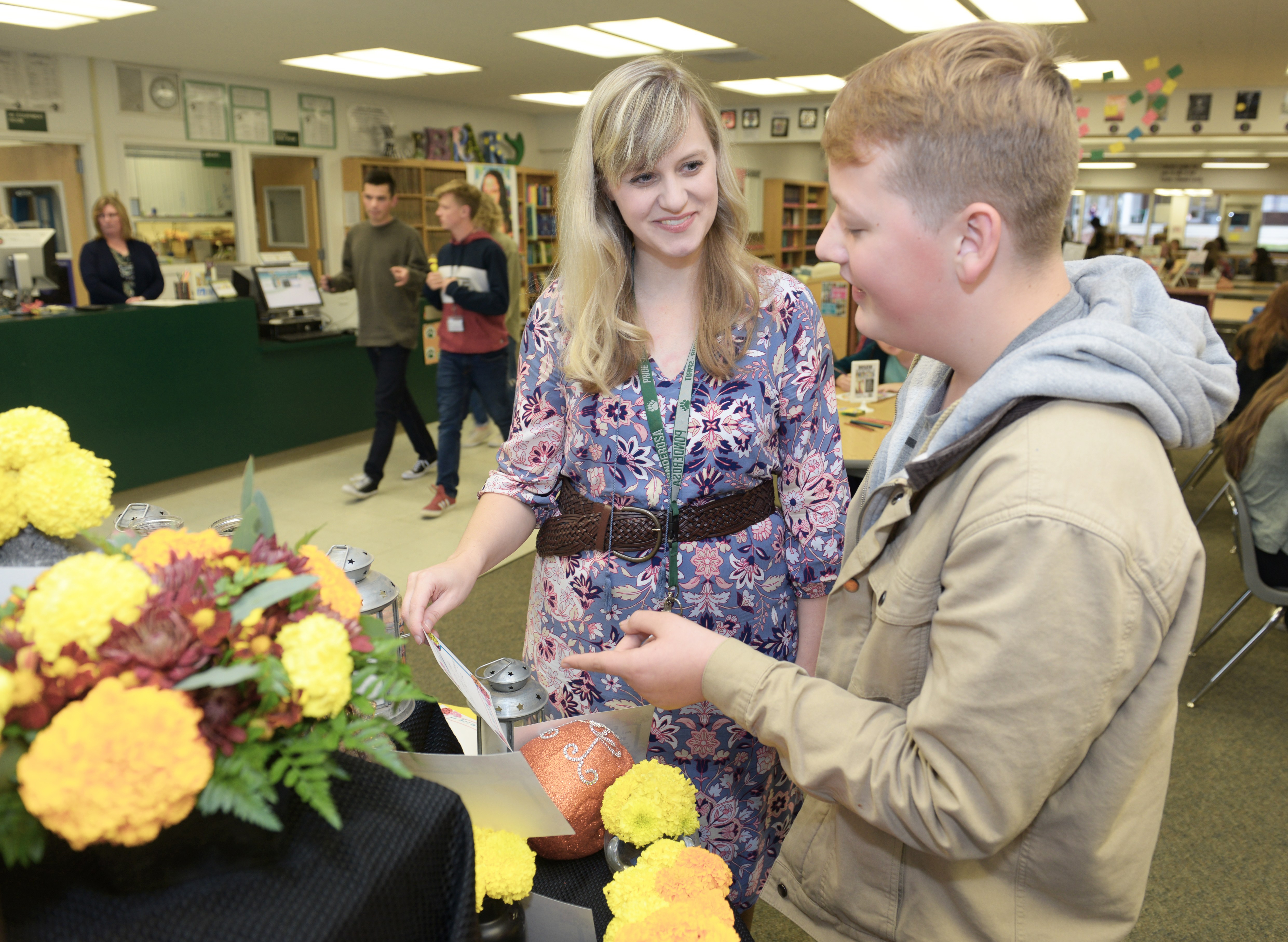
Teacher librarian Jennifer Zimny with a student at the Day of the Dead altar she created in Ponderosa High School’s library.
Britta Fletcher, an English and floral design teacher at the school, recently collaborated with Zimny on a Day of the Dead project that was extremely popular with students. Students made skull decorations for the Mexican holiday and wrote cards to remember special people in their lives who were no longer living, placing them on an altar decorated, of course, with flowers.
“She had great ideas about how to implement art and a technical component. She pointed me in the right direction with books and databases,” says Fletcher. “It was very helpful.”
Virginia Hamilton, a teacher librarian at Union Mine High School in El Dorado, often attends her school’s department meetings so she can explain to teachers how she can assist them.
“It helps to promote ourselves,” says Hamilton. “By doing so, teachers find out we are very supportive of what they do.”
Librarians, funding in short supply
Teacher librarian positions are often on the chopping block, and school libraries are threatened with cutbacks or closures in tough times. Despite preparing students for college and the workforce, teacher librarians are lacking on many campuses.
In some schools without teacher librarians, nonteaching staff provide library services. And in others the libraries have closed. In 2014, EdSource reported that about half of the 600 elementary and middle school libraries in Los Angeles Unified School District had closed. That same year, the School Library Journal reported that 40 of San Diego Unified School District’s 180 libraries were closed due to budget cuts.
“Currently in Oakland, it’s possible to enter kindergarten and graduate high school never having gone to a school that has a library,” said a district librarian in the EdSource story.
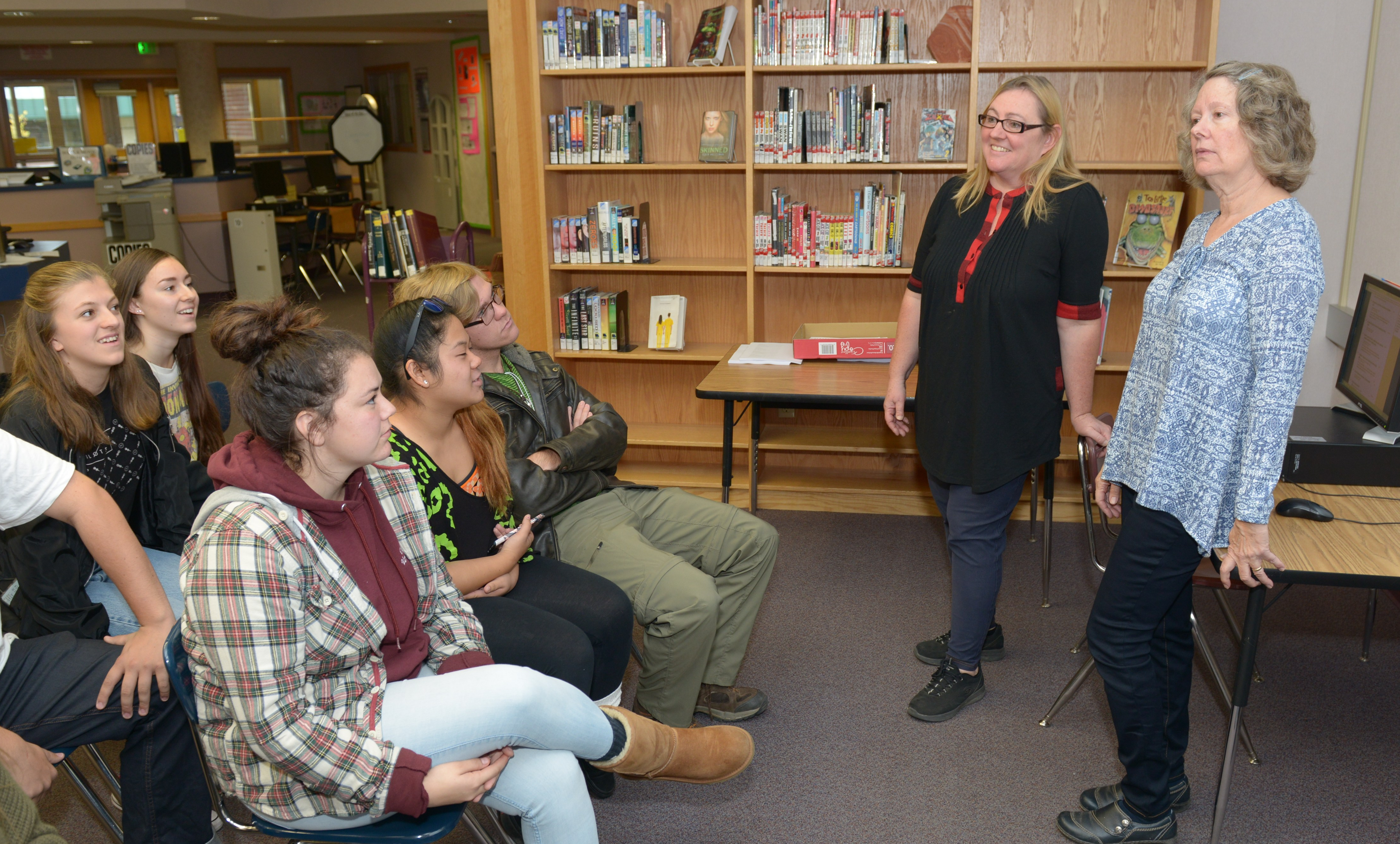
Union Mine High School librarian Virginia Hamilton, right, and classroom teacher Stephanie Luther team up for students.
State law requires California public schools to provide library services to students — but has yet to define the minimum level and types of library services public schools must provide. SB 390, a CTA-sponsored bill, would have adopted model standards and regulations for school library services, but Gov. Jerry Brown vetoed it in October.
After categorical funding ended in 2009, the primary source of library funding for 51 percent of California schools was fundraising.
However, the news is not all bleak. Since implementation of the Local Control Funding Formula in 2013-14, funding provided by districts has steadily increased from 28 percent in 2011-12 to 45 percent. But in some districts, even that is not enough.
“There haven’t been layoffs in my district,” says Virginia Hamilton in El Dorado. “We are valued and supported. But a neighboring school district did away with its librarians a few years ago, so we consider ourselves lucky.”
Libraries help students succeed
More than 60 studies have produced evidence that school library programs staffed by teacher librarians have a positive impact on student achievement. Public schools with strong library programs staffed by credentialed librarians outperform schools without such programs, regardless of a community’s parent education, poverty level or percentage of English learners.
Among other benefits, school libraries:
- Present programs that foster critical thinking, providing students with the skills they need to analyze, form and communicate ideas.
- Are learning hubs and homework help centers where students use technology and the latest information resources, preparing them for college and the workplace.
- Can have strong programs that instill confidence in reading, which promotes learning, personal growth and enjoyment.
- Foster a safe, caring climate — they are often the one place in school that is open to all students, where teacher librarians can support students across grade levels and subject matter.
Angela Anthony
Hercules Middle School
United Teachers of Richmond
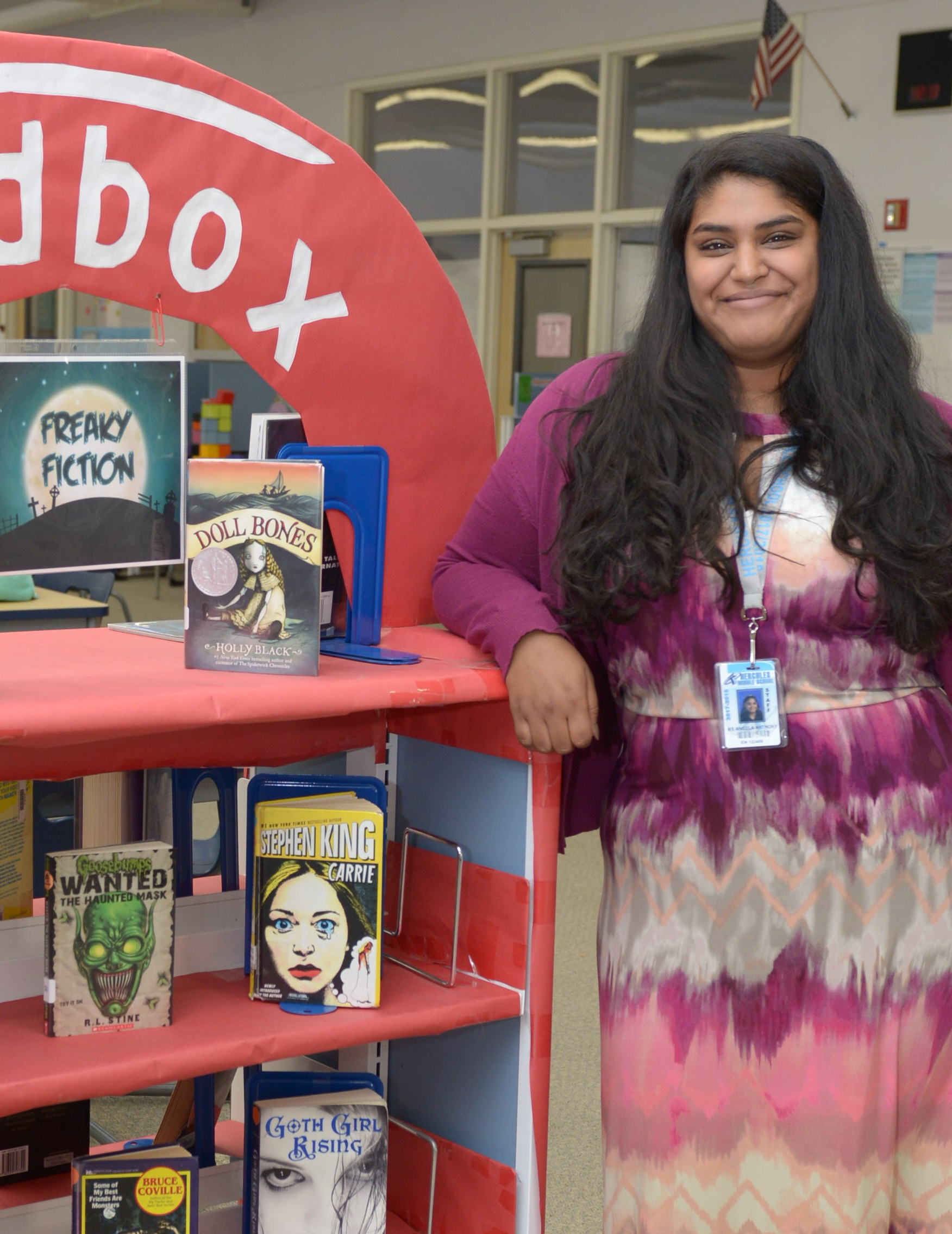 Angela Anthony considers herself one of a new breed of librarians who enjoy innovation and trying new things. She sometimes teaches or co-teaches lessons in regular classrooms, such as one she recently created to educate students about plagiarism and its consequences.
Angela Anthony considers herself one of a new breed of librarians who enjoy innovation and trying new things. She sometimes teaches or co-teaches lessons in regular classrooms, such as one she recently created to educate students about plagiarism and its consequences.
“I love integrating technology and literacy in our school,” says Anthony, who assists students with creating videos and introduces them to databases for school research projects.
She started an accelerated reading program to promote reading for fun and prizes — with a Google Classroom component where students submit book reviews for peers. Her after-school Library Club will compete against other school library clubs in a Battle of the Books contest.
A Makerspace Club meets after school in the library, and she plans to hold a Makerspace Fair for the public to see what students create on the library’s 3-D printers.
“People think that all I do is sit and read and take care of books all day,” she laughs. “But I am just like a regular teacher who is busy all day long. I never sit down. Lunchtime is my busiest time.”
She is proud the library is a safe space for students at lunchtime and before and after school.
“Some kids did not feel a sense of belonging at school,” she says. “I love that all kids are welcome in the library.”
Sue Navarro
Fresno High School
Fresno Teachers Association
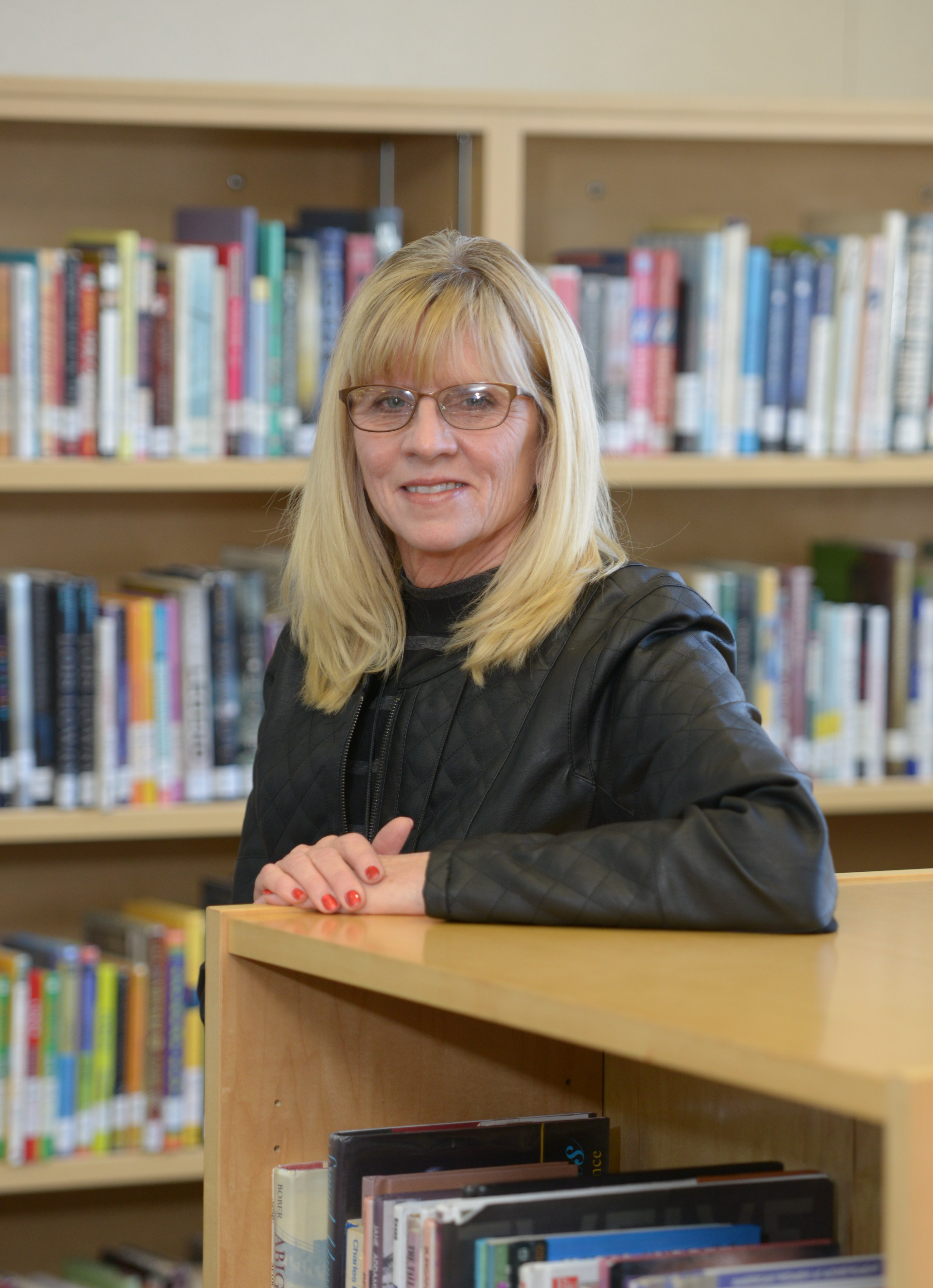 Among the library’s wide array of programs and services that Sue Navarro manages are e-books that students access from the Fresno Unified site or the county library system, and can read on their own devices. She also manages their access to the library webpage for research and resources.
Among the library’s wide array of programs and services that Sue Navarro manages are e-books that students access from the Fresno Unified site or the county library system, and can read on their own devices. She also manages their access to the library webpage for research and resources.
The teacher librarian hosts many activities, including:
- A book club that meets in the library for lunch.
- Banned Books Week in September.
- Cocoa Fridays with hot chocolate, puzzles and games before school.
- A 12-hour freshman “Read-A-Thon” in November.
- Book fairs, mobile book carts, and free book giveaways for home libraries.
- A Maker Fair where students show what they have made and share what they have learned.
- Shakespeare’s Trash Talk ’N Throwdown, a celebration of the Bard’s birthday for ninth-graders.
- Hour of Code, an introduction to computer science.
Navarro has created thought-provoking exhibits in the library, including “The Power of Influence,” examining the influence of media on public opinion, and “The Courage to Remember,” about the Holocaust.
A decade ago, when she began her job, she wondered why the library was usually empty. Now, when the library opens its doors at 7:15 a.m., students are waiting to enter.
“We completely changed,” says Navarro. “I call this the happiest place on campus and the heart of the school. I love being a part of it.”
Jennifer Zimny
Ponderosa High School
El Dorado UHSD Faculty Association
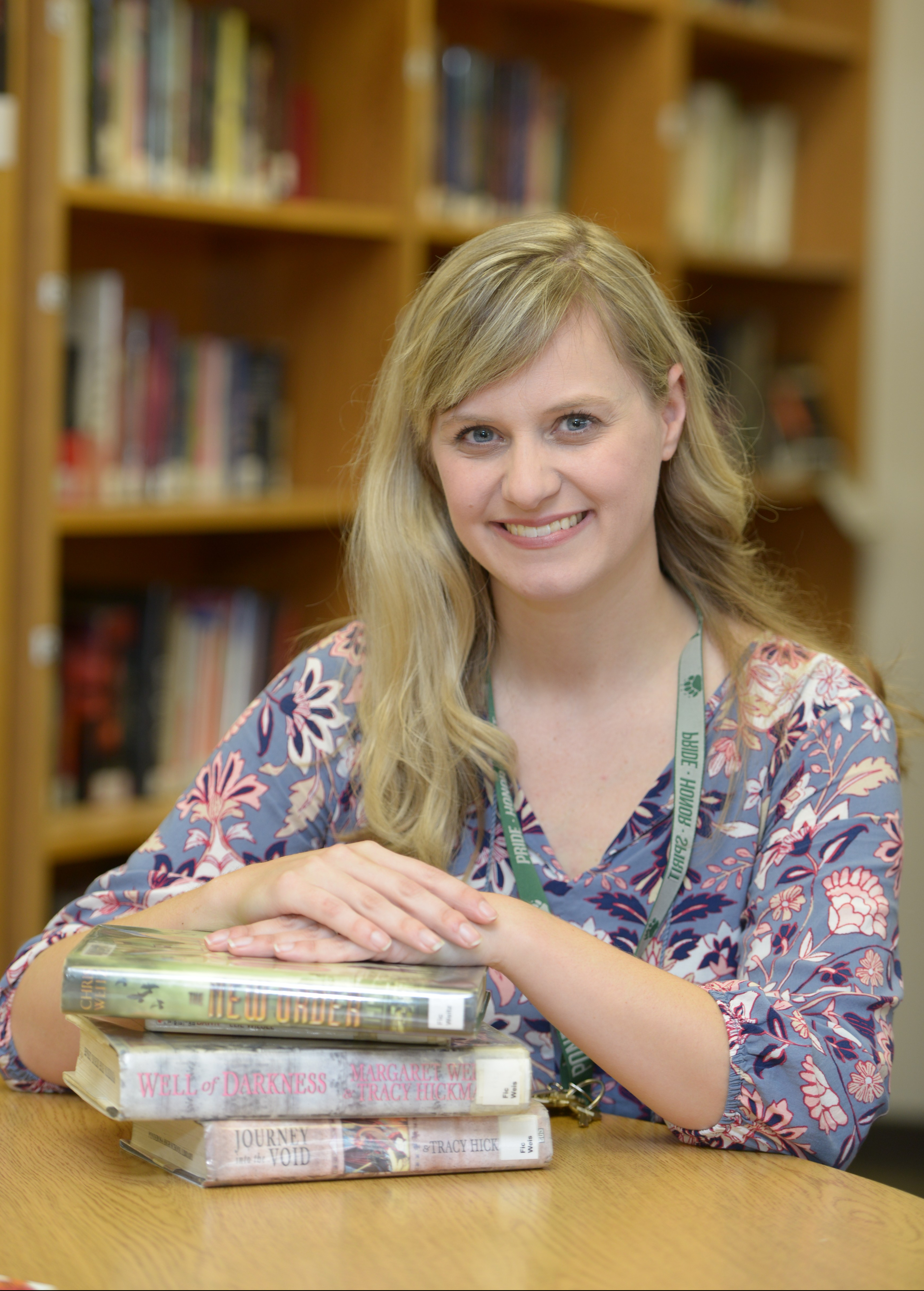 Before she was a teacher librarian at Ponderosa High, Jennifer Zimny was a drama teacher for nine years there. The switch was a success. Last year she won the Good Ideas Award from the California School Library Association (CSLA) for a two-week project called “The Health of the Planet.” It was designed to teach ninth-graders how to conduct research using Science In Context, an online database that provides contextual information on hundreds of science topics ranging from bacteria to obesity and weather.
Before she was a teacher librarian at Ponderosa High, Jennifer Zimny was a drama teacher for nine years there. The switch was a success. Last year she won the Good Ideas Award from the California School Library Association (CSLA) for a two-week project called “The Health of the Planet.” It was designed to teach ninth-graders how to conduct research using Science In Context, an online database that provides contextual information on hundreds of science topics ranging from bacteria to obesity and weather.
“I wanted students not just to Google topics, but learn how to do research, use Cornell note-taking, make citations, and synthesize all the information into a presentation, which will help them throughout high school and college,” says Zimny. “Students also created Google Slide presentations.”
She conducts makerspace workshops and origami workshops, and uses Ozobot Coding Robots to introduce students to computer programming. By using different color combinations on the bots, students can make them follow different instructions.
“I love how school libraries are becoming livelier,” she says. “The school library is the heart of a school. It’s a place where kids can wonder about the world. Hopefully, school libraries also stimulate students to love reading so much that they become lifelong learners.”
Virginia Hamilton
Union Mine High School
El Dorado UHSD Faculty Association
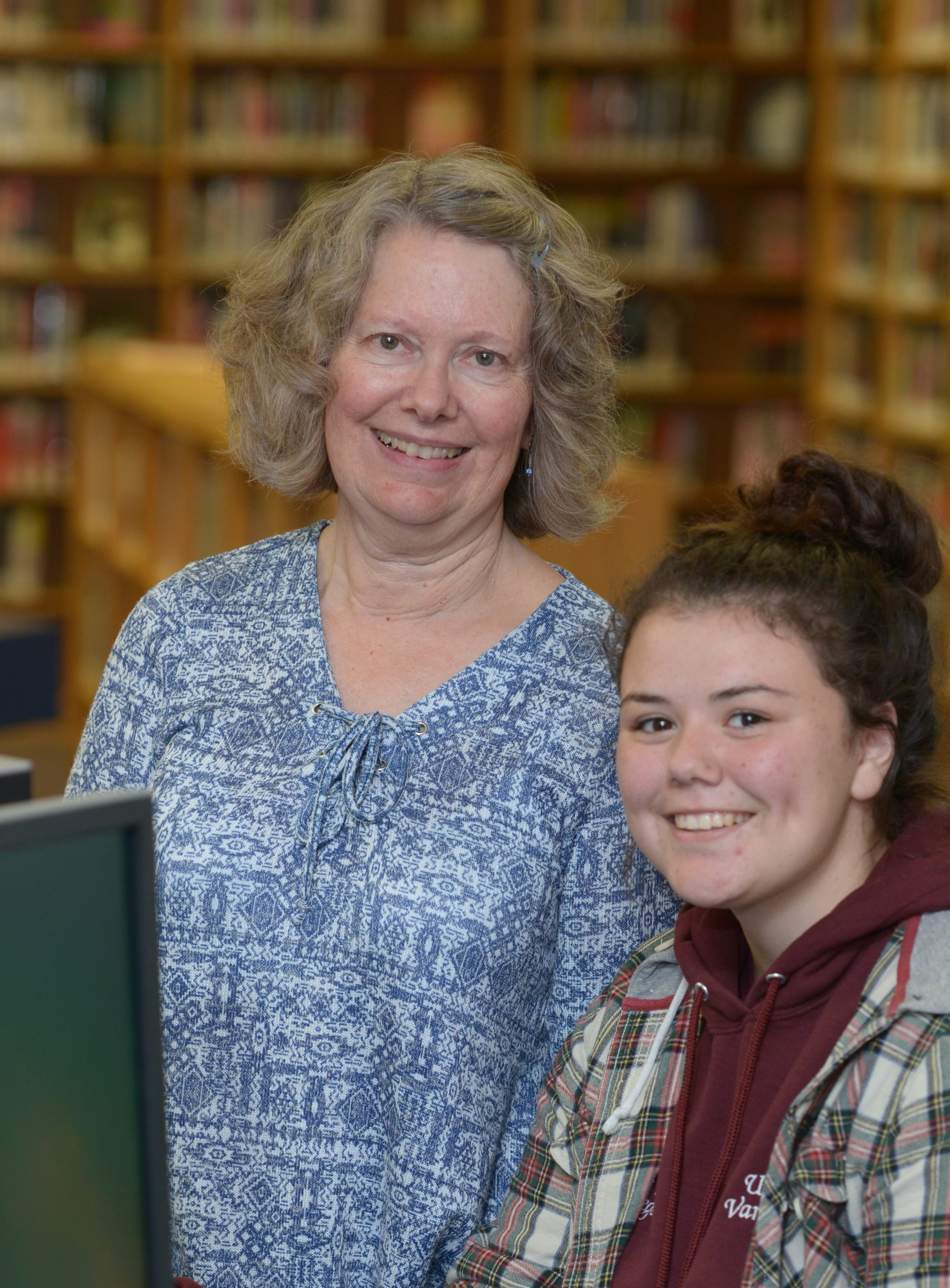 What Virginia Hamilton likes best about being a teacher librarian is that every day is different.
What Virginia Hamilton likes best about being a teacher librarian is that every day is different.
“Yesterday I had 13 classes where students had ‘mad money’ and learned how to write checks, take care of a debit card, and figure out how much money they might need to join a gym, buy a car, rent an apartment or buy baby formula. I was mobbed in those classes. The day before that, seniors were doing research for One Flew Over the Cuckoo’s Nest and the computers went down, so I had to show them print resources. Today, I showed students how to use a database for U.S. history, world history, science and literature, and helped them save articles to their Google Drive. I never have the same day twice, and I love that about my job.”
After attending a California School Library Association (CSLA) conference, she learned about e-cards and collaborated with colleagues to pilot the cards at school, so students can log in and access the school library’s databases from anywhere. She posts her favorite books regularly online and organizes scavenger hunts for prizes, where students must find things hidden in the pages of books.
Hamilton, a reference librarian in a public library for 19 years before earning her teaching credential, won a Good Ideas Award in 2016 from CSLA for her work with Spanish classes assigned to study a Spanish-speaking country. Students created posters to lure tourists, cooked native cuisine and brought in dishes to share, enjoyed music on YouTube from that country’s top artists, and created presentations using Prezi software.
“It looked like an insane asylum while the kids were running around,” she laughs. “But the students were very involved in this project, learned a lot, and had a great time.”
By the numbers
9%
Percentage of California schools with credentialed teacher librarians (part-time or more). Most of them are at the high school level.
1:7,187
California’s ratio of teacher librarians to students in 2014-15.
50th
California’s national ranking in ratio of teacher librarians to students. The state continues to rank at the bottom of professional library staffing numbers.
Source: California Department of Education
Featured photo caption: Teacher librarian Jennifer Zimny, Ponderosa High School, El Dorado UHSD Faculty Association, with a student at the “altar” she helped create for Day of the Dead festivities.
The Discussion 0 comments Post a Comment